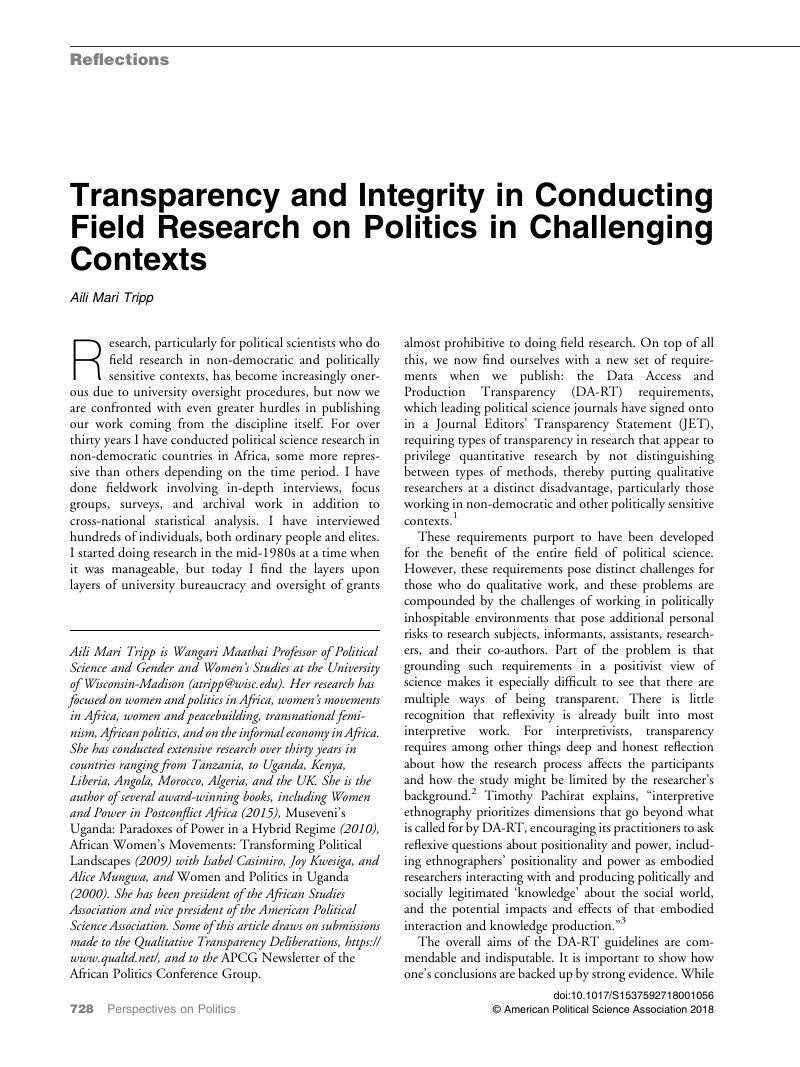Crossref Citations
This article has been cited by the following publications. This list is generated based on data provided by Crossref.
Jacobs, Alan M.
Buthe, Tim
Arjona, Ana M
Arriola, Leonardo R.
Bellin, Eva
Bennett, Andrew
Björkman, Lisa
Bleich, Erik
Elkins, Zachary
Fairfield, Tasha
Gaikwad, Nikhar
Chestnut Greitens, Sheena
Hawkesworth, Mary
Herrera, Veronica
Herrera, Yoshiko M.
Johnson, Kimberley S
Karakoç, Ekrem
Koivu, Kendra
Kreuzer, Marcus
Lake, Milli
Luke, Timothy W.
Morris MacLean, Lauren
Majic, Samantha
Maxwell, Rahsaan
Mampilly, Zachariah
Mickey, Robert
Morgan, Kimberly J.
Parkinson, Sarah
Parsons, Craig
Pearlman, Wendy
Pollack, Mark A.
Posner, Elliot
Riedl, Rachel Beatty
Schatz, Edward
Schneider, Carsten
Schwedler, Jillian M.
Shesterinina, Anastasia
Simmons, Erica
Singerman, Diane
Soifer, Hillel David
Smith, Nicholas
Spitzer, Scott
Tallberg, Jonas
Thomson, Susan
Vázquez-Arroyo, Antonio
Vis, Barbara
Wedeen, Lisa
Williams, Juliet
Wood, Elisabeth Jean
and
Yashar, Deborah
2019.
Transparency in Qualitative Research: An Overview of Key Findings and Implications of the Deliberations.
SSRN Electronic Journal,
Shesterinina, Anastasia
2021.
Sources of evidence and openness in field-intensive research on violent conflict.
Politics, Groups, and Identities,
Vol. 9,
Issue. 4,
p.
851.
Lischer, Sarah Kenyon
2021.
Hypotheses on Agony: Field Research in a Genocidal Context.
PS: Political Science & Politics,
Vol. 54,
Issue. 2,
p.
276.
Cantin, Marc-Olivier
2021.
Pathways to Violence in Civil Wars: Combatant Socialization and the Drivers of Participation in Civilian Targeting.
International Studies Review,
Vol. 23,
Issue. 4,
p.
1566.
Gaikwad, Nikhar
and
Herrera, Veronica
2021.
Transparency for Text-Based Sources: From Principles to Practice.
SSRN Electronic Journal ,
Grossman, Jonathan
and
Pedahzur, Ami
2021.
Can We Do Better? Replication and Online Appendices in Political Science.
Perspectives on Politics,
Vol. 19,
Issue. 3,
p.
906.
Krystalli, Roxani
2021.
The Companion to Peace and Conflict Fieldwork.
p.
35.
Kapiszewski, Diana
and
Karcher, Sebastian
2021.
Transparency in Practice in Qualitative Research.
PS: Political Science & Politics,
Vol. 54,
Issue. 2,
p.
285.
Thaler, Kai M.
2021.
Reflexivity and Temporality in Researching Violent Settings: Problems with the Replicability and Transparency Regime.
Geopolitics,
Vol. 26,
Issue. 1,
p.
18.
Fu, Diana
and
Simmons, Erica S.
2021.
Ethnographic Approaches to Contentious Politics: The What, How, and Why.
Comparative Political Studies,
Vol. 54,
Issue. 10,
p.
1695.
Jacobs, Alan M.
Büthe, Tim
Arjona, Ana
Arriola, Leonardo R.
Bellin, Eva
Bennett, Andrew
Björkman, Lisa
Bleich, Erik
Elkins, Zachary
Fairfield, Tasha
Gaikwad, Nikhar
Greitens, Sheena Chestnut
Hawkesworth, Mary
Herrera, Veronica
Herrera, Yoshiko M.
Johnson, Kimberley S.
Karakoç, Ekrem
Koivu, Kendra
Kreuzer, Marcus
Lake, Milli
Luke, Timothy W.
MacLean, Lauren M.
Majic, Samantha
Maxwell, Rahsaan
Mampilly, Zachariah
Mickey, Robert
Morgan, Kimberly J.
Parkinson, Sarah E.
Parsons, Craig
Pearlman, Wendy
Pollack, Mark A.
Posner, Elliot
Riedl, Rachel Beatty
Schatz, Edward
Schneider, Carsten Q.
Schwedler, Jillian
Shesterinina, Anastasia
Simmons, Erica S.
Singerman, Diane
Soifer, Hillel David
Smith, Nicholas Rush
Spitzer, Scott
Tallberg, Jonas
Thomson, Susan
Vázquez-Arroyo, Antonio Y.
Vis, Barbara
Wedeen, Lisa
Williams, Juliet A.
Wood, Elisabeth Jean
and
Yashar, Deborah J.
2021.
The Qualitative Transparency Deliberations: Insights and Implications.
Perspectives on Politics,
Vol. 19,
Issue. 1,
p.
171.
Schwartz-Shea, Peregrine
2021.
Under Threat? Methodological Pluralism in Public Administration.
Public Performance & Management Review,
Vol. 44,
Issue. 5,
p.
975.
Elischer, Sebastian
2021.
Salafism and Political Order in Africa.
Krause, Jana
2021.
The ethics of ethnographic methods in conflict zones.
Journal of Peace Research,
Vol. 58,
Issue. 3,
p.
329.
Kapiszewski, Diana
and
Wood, Elisabeth Jean
2022.
Ethics, Epistemology, and Openness in Research with Human Participants.
Perspectives on Politics,
Vol. 20,
Issue. 3,
p.
948.
Kostovicova, Denisa
and
Knott, Eleanor
2022.
Harm, change and unpredictability: the ethics of interviews in conflict research.
Qualitative Research,
Vol. 22,
Issue. 1,
p.
56.
Hunt, Stacey L.
2022.
Sexual Harassment and Assault During Field Research.
PS: Political Science & Politics,
Vol. 55,
Issue. 2,
p.
329.
Alaoui, Hicham
2022.
Pacted Democracy in the Middle East.
p.
1.
Johnson, Janet Elise
2023.
Authoritarian Gender Equality Policy Making: The Politics of Domestic Violence in Russia.
Politics & Gender,
Vol. 19,
Issue. 4,
p.
1035.
von Soest, Christian
2023.
Why Do We Speak to Experts? Reviving the Strength of the Expert Interview Method.
Perspectives on Politics,
Vol. 21,
Issue. 1,
p.
277.



